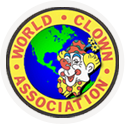By Janet “Jelly Bean” Tucker – Alley Director
As I was thinking about what to write for this article, the word “ensemble” kept popping into my head as a technique to share with our WCA alleys. I’m writing this in November and I have just returned from a wonderful clown training program presented by Randy Christensen, WCA Master Clown, where I had the opportunity to serve on staff with Randy and Angel Ocasio. Randy has offered these “Next Step” advanced trainings for a number of years but they are limited to only 15 people and it is training in advanced performing skills. This recent workshop was in Minneapolis, MN, and the attendees were all properly advanced in their performance areas so that they could really profit from this “Next Step” training.
A large variety of techniques were covered but the one that continues to come back to me is “ensemble”, the various techniques and body movements and skills that are required to work together with 2 or more other clowns. Ideas of focus and upstaging and body movements and proper blocking techniques are all important to working with a group and, as I’m writing this article for alleys, the concepts seem made to order for alley groups doing skits and performances. Even just being with a group at something like a festival or Relay for Life requires that you be aware of what the other clowns are performing and who they are working with so you can interact in a positive way with your own entertainment skills.
At the Next Step, we worked on how to throw focus with body techniques. I find that these techniques are perfect for performing but also work in all areas of everyday interaction with others. For example, if you can imagine a large spotlight in the middle of your chest, where that spotlight is aimed is the center of your focus at the moment. When you are in active conversation with someone, you show your attention by facing the person so your spotlight shines on their spotlight, “face to face” or “head to head”, which describes the terms we use for close communication. Face to face is how we like to meet with people when we want to discuss something important. Head to head seems like a more aggressive term but is likewise a close encounter meeting.
Now consider that as your conversation winds down, you turn your body spotlight away and begin to move away, even though many times your face still stays turned to the person. You are indicating that your conversation is winding down and you are going to move, first by turning your body and then by turning your head away. You can use this technique when your alley is performing a skit for others. You can also be aware of it in day-to-day conversations with others so you can properly wind down any conversation and turn your focus away.
Another technique that we need to be aware of in group performance is “upstaging”. The term comes from the ancient amphitheater stages that were raised in the back for better viewing. It means someone behind is stealing the focus, sometimes by doing something they should not be, rather than allowing the person “on” at the moment to get the attention. Sometimes you want focus to shift to the clown behind to move the skit forward. In the classic skit, Balloons For Sale, the person with the bunch of balloons is selling them in front when another clown peeks out upstage with a large pin. The focus shifts to the pin and anticipation of when and how this clown will pop the balloons. This is appropriate shifting of the focus in this skit. However, when the person with the action loses focus because someone upstage is wiggling, making noises, picking his nose, or making silly faces, that is not appropriate shifting of the focus. Sometimes we have to work with clowns who just want to be the center of attention all the time and that reduces the impact of “ensemble” clowning as well as watering down our performances.
Learn to work together to place the focus squarely on the one talking or carrying the action by your body position, by being quiet and attentive to the other person, and by being more animated and in the focus when it is your turn to carry the skit. Mesh your movements into those of others on stage with you. Take turns being active or being quieter, being the one speaking or the one sneaking around behind. In the Classic Skit Bandana Banana, the clown behind gathers the focus as he is the one folding a banana instead of the bandanna. The clown in front has to monitor the talking, the folding, and the movements to allow the clown behind time to work the skit and generate the laughs by the misunderstanding.
The more you learn about ensemble performance, focus, appropriate upstaging, and stage movement, the stronger your alley skits will be. Practice these techniques at an alley meeting until you understand the movements in the skits that your alley performs. Practice these techniques so you complement the skills of the other clowns making balloons or face painting when you are together at an event. Let your alley clown events be ensemble clowning at its most professional level.
